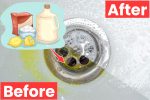Eating healthy is a priority, but it’s not as simple as you might think. Sadly, labeling laws have many loopholes, and companies make use of them to conceal a few not-so-healthy ingredients that you would avoid if you only knew they were there.

To eat healthily, you must know what goes into your body, but after you read this, you won’t be fooled easily. These are 11 hidden messages in packaged food labels you should look out for. Your body will thank you.
#11 – If Too Long to Read, Avoid
Here’s a simple rule that won’t take you more than a few seconds. No healthy food should have over twenty ingredients. Processed food depends on artificial flavorings, sweeteners, preservatives, emulsifiers, colorants and much more, so the food itself might not be particularly good looking or tasty.
Avoid lengthy ingredient lists, as easy as that. You’ll be avoiding processed foods and junk food like a pro.
#10 – The Secret Behind the Order of Ingredients
If you’re buying chicken and the first ingredient of the list is not chicken, then you’re in trouble. Ingredients are listed in order of importance, so the first few ingredients make the most of the product.
If you can’t inspect a label thoroughly, at least look at the first ingredients and you’ll know what you’re dealing with. Soy is often used instead of meat, for example, a clear sign you’re not really buying what you wanted to buy.
#9 – I Can’t Believe It’s Not Butter
Most buttery things like margarine, popcorn and most industrial baked treats are not made with butter but with trans and saturated fats flavored with Diacetyl, a compound that smells and tastes like butter.
Diacetyl is frowned upon since scientific evidence is piling up against it. The butter impostor is even linked to some cancers.
#8 – Look for Fiber and Protein
For snacks, there’s an easy way to know if you’re just eating carbs and sugars or if you’re actually eating something with nutrients on it.
Fiber and protein are regularly a sign of whole grains, seeds and healthy cereals that are much better than white flour. The unhealthiest treats will never have protein or fiber. And although this information alone is not enough to decide if you buy something, it’s a good start.
#7 – Avoid High Sugar Contents
If you don’t have time to look closely at all the ingredients listed, look at this single fact: the total amount of sugars. If it seems too high, avoid. Again, this is not the complete picture, but it helps.
This tactic is especially useful when comparing two similar items, choose the one with less sugar and you’ll already be making a better choice.
Sugar is not the enemy, is overdoing it what hurts you, and most processed food is packed with it.
#6 – High Fructose Syrup, The Big No-no
High fructose syrup sweetens everything from candy to soft drinks, and it’s because it’s cheap. The problem with the sweetener is that it’s linked with obesity, diabetes, heart diseases and cancer. If you care for yourself and your family, avoid high fructose syrup.
The reason behind these dangers is that our bodies don’t know how to process the substance adequately as it mistakes it for sucrose, which is a much safer choice.
#5 – Calories Count
Counting calories is a safe way of making sure you’re not getting more energy than what you need. Excess energy is stored as body fat, and burning it is incredibly hard. An average person should eat 2,000 calories a day, although we’re all different.
Now listen to this. The calories listed on labels are per serving, and not per package, so you might end up eating four times more calories than you thought if you don’t read carefully.
#4 – Wine Might Not Be Vegetarian After All
Wine is tasty and quite healthy in moderation, but labeling laws for the fermented grape juice are far behind other industries.
Ingredients in wine labels are almost inexistent, although wine can have plenty more ingredients than grapes. Some ingredients are even animal based, like isinglass, used to clarify the wine — they get it from fish bladders. So much for wine being vegan!
#3 – Jell-O Just Became Disgusting
As kids we love jell-o, but more often than not it loses its charm as we grow up. Perhaps that’s not that bad, since gelatin is made with collagen, obtained from animal parts. We just thought you should know.
And gelatin is present in lots of desserts and even savory foods, so if you’re trying to avoid animal-based products, then stay clear from gelatin.
#2 – GMS and All Its Disguises
GMS is an interesting compound. It is one of the most used food additives because it tastes delicious, literally. GMS tastes like umami, the fifth flavor after salty, bitter, sour and sweet, and it can only be described as delicious.
The problem is that companies have been using GMS to make us eat more than we should, particularly of junk food. The secret is out, but companies still use GMS and add it to ingredient lists with other aliases like Glutamate, Glutamic Acid, Amino Acids and Autolyzed Yeast Extract. Even if you prefer to avoid GMS, it’s not always easy to spot.
#1 – Sugar for Days
Another dangerous ingredient often listed in disguise is sugar. Agave nectar, barley malt, caramel, corn syrup, dextrose, fructose, honey, lactose and molasses are just a few alternative names for sugar you should monitor.
Processed food companies will do anything to disguise the massive amounts of sugars in their products.
As If Following a Healthy Diet Wasn’t Hard Enough Already!
Inspecting food labels is hard work, but it’s totally worth it if you want to take care of your body weight and overall health.
Relying less on store-bought products and cooking some things like bread, jams, pizzas and pastries at home is a wonderful alternative too, in which you know exactly what you’re eating.
The fact is, we need better labeling laws, and more information because the food we buy should be healthy and never a hazard. This might not change soon, so spend some time looking for sneaky unhealthy ingredients on labels.


